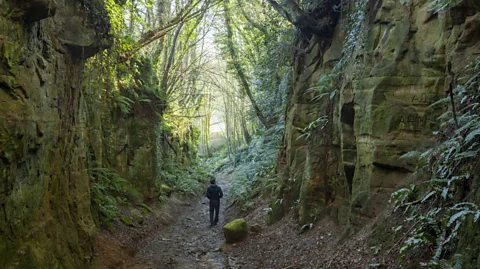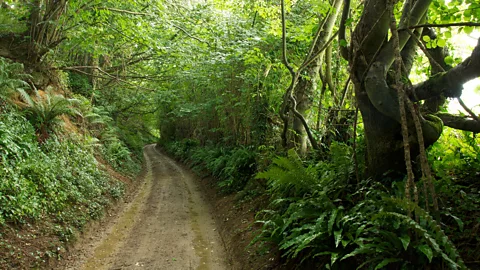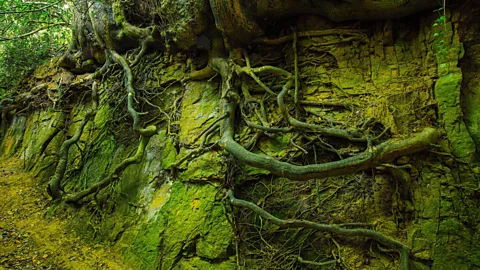England's mysterious sunken roads
 James Osmond/Getty Images
James Osmond/Getty ImagesA new mapping project by Natural England will help unearth the deep history and mystery of this ancient network of subterranean tracks.
The path began to descend into the earth as if burrowed out in ancient times by the slithering of a giant worm. As we followed it downwards, the atmosphere changed: the wind became still, the air warmer. The plant life changed, too, the verges of the path becoming a jungle of curling ferns. Up ahead, as the ageway became deeper and the banks on each side reared higher, the sky became obscured by the branches of crowning trees, which in a couple of months' time would be flush with the green canopy of summer – completing the illusion of a little hidden netherworld.
I was standing in Shute's Lane, one of the most famous of the sunken paths known as "holloways" that riddle the southern English county of Dorset. Accompanying me were ecologist Andy Jefferies and archaeologist Rosie Cummings, who are leading a project with Natural England that aims, for the first time, to map this ancient network across the region using state-of-the-art 3D cameras alongside crowdsourced reports from hikers and locals on the ground.
Holloways have lent their name to places and people alike. There is a London neighbourhood called Holloway; towns of the same name in Minnesota and Ohio; and a number of famous people who bear the word as a surname, from English comic actor Stanley Holloway to American poet Ariel Williams Holloway. It's a common enough word that most people have probably never stopped to think about what it means – quite simply, a "hollow way"; a path or lane hollowed out into the soft earth. As for the name, Ancestry lists it as a "topographic name for someone who lived '(by the) sunken road' from Middle English hol(g)h 'hollow' + weie 'way'."
Some holloways are wide enough to have been tarmacked and now have roads running through them; others remain as footpaths; yet more have become overgrown and forgotten. The thing that unites them is that they are not natural features. Instead, they have been slowly eroded away by human activity: footpaths and livestock routes, carved into deep lanes by millions of footsteps.
 Andrew Wood/Alamy
Andrew Wood/Alamy"Holloways are lower than the surrounding field levels because they have been created by movement of people – not deliberately, but over thousands of years," explained Jefferies, as we stood around 10ft below the adjacent countryside. Holloways are found all over the world, he explained, but a variety of factors – including soft bedrock and a long history of habitation – have come together to make southern England, and Dorset in particular, a hotspot. (There are around 40 miles of holloways in Dorset, by Jefferies' reckoning, out of around 1,000 total holloway miles in England.)
Mapping the network
Natural England are planning to publish the results of their holloway mapping project in late 2023, with a nationwide map to follow.
"To make a holloway, you need soft rock, a hill and rain – and people needing to get from A to B. Feel how soft this rock is; it's Bridport sandstone," he said, his hand easily brushing some crumbly particles away from the wall. Footsteps have worn down a gully in this soft rock, which gradually, combined with rainwater flowing down at the right angle, has become a deep tunnel.
While most habitats are degraded by human activity, holloways depend on it. "If you leave them alone, they become overgrown," Jefferies said. "The dynamics of sunlight and exposed rock would all change, and many of the species would leave." The unique, manmade topography of holloways creates conditions for unusual ecosystems to thrive. "At the canopy level, you get nice native woodland," Jefferies said, motioning to the ash and beech trees that crowned the holloway's banks. "Then, underneath, you get this weirder stuff. These hart's-tongue ferns are a really old species – the stable, warm, humid environment of a holloway s species like this, which are specialist and aren't adapted to variation.
"Up there," he motioned to the world above with what I'm sure was a touch of disdain, "with agriculture, exposed air, bright sunlight – these things can't live."
 Savo Ilic/Alamy
Savo Ilic/AlamyThe unique atmosphere of the holloways leads even scientific minds into states of treasure-seeking wonder. For Jefferies, the holy grail is goblin's gold, a vivid green moss that glows in the dark like a carpet of emeralds. It's been spotted in Hell Lane, which is connected to Shute's Lane, before, and he remains hopeful he can find it – although, as he noted sadly, it's not been seen since the 1960s.
It's not just rare plants that make their homes here. Badgers and rabbits have been seen on camera traps using holloways as highways between woodland areas, and the earthen walls of Shute's Lane were clearly pockmarked with tiny holes where mason bees made their nests. "Insects, fungi, bryophytes; they all like these damp, stable conditions," Jefferies said. "We've counted at least three amber-listed [threatened in the UK] bird species: dunnock, song thrush and bullfinch. There is likely to be more."
As they get older and more deeply trodden, holloways become wider at the bottom than they are at the top. Looking up, this gives the impression that the walls are closing in. The sides burrow out laterally to expose balls of roots, making trees appear half-suspended in mid-air. It contributes to the impression of being in a hidden chamber, perceiving the overworld from forbidden angles like a glitch in a video game. "It makes you wonder," said Jefferies, as we ed one of these knotted tangles of roots ing a giant ash tree, "is it the wall holding the tree up, or the other way around">window._taboola = window._taboola || []; _taboola.push({ mode: 'alternating-thumbnails-a', container: 'taboola-below-article', placement: 'Below Article', target_type: 'mix' });
